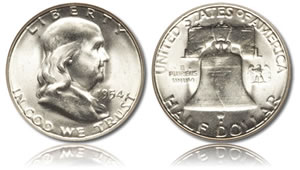
News has been ripe with consequences — both good and bad — of silver prices soaring to fresh highs.
On the positive for those positioned, silver coin values are shooting through the roof. But on the bad, high silver prices have caused product suspensions, raised coin prices and other negative changes from governmental mints.
Silver reached over $46 an ounce to end the week, bringing intrinsic silver coin values to highs not seen since the Hunt brothers attempted to corner the silver market in 1980. At that time, silver prices rose just over $50 an ounce for a short span in January. Many think that record could be broken soon.
The impact of higher silver prices is very visible when comparing the value of American coins dated before 1965. Those coins were struck from 90 percent silver. As such, and as a single example, a Franklin half-dollar then was worth its face value. Today it is worth nearly $17.
The United States Mint had already raised the prices of its silver products this year as compared to last year. But it has since gone through three distinct product suspensions — in early March, early April, and then again on April 19. Now all of its silver proof sets are on hold, awaiting a leveling of precious metals prices so it can place them back on sale.
The Mint’s gold products are much higher this year as well. On October 7, the United States Mint issued its proof 2010 American Gold Eagles. The largest one ounce size started at $1,585. This Thursday the Mint released its proof 2011 American Gold Eagles. The starting price of the one ounce coin was $1,735, or $150 more. This is just one example.
Other world mints have been faced with making product adjustments as well due to higher silver prices. One example is Germany halting its uncirculated silver £10 commemorative coins for circulation, with plans that new versions would instead have a composition of copper-nickel.
Coin news articles on several of the topic briefly detailed above are available in the following news stories:
Silver Coin Values Shocking As Silver Prices Hit Highs
Mike Unser | CoinNews.net
It is difficult to imagine that a 50-cent piece with mintages in the tens of millions is worth nearly $17, or that a worn out nickel is valued at more than $2.50. But they are, thanks to silver prices that have jumped 172 percent since the end of 2009. Coins with 90 percent silver include dimes, quarters and half dollars that were minted before 1965. These are now worth an amazing amount of money today. For example, a Kennedy half dollar was exchanged at face value …
Values for Coins Composed of Silver Explode
Staff | SilverCoinsToday.com
Those owning junk silver coins can either use them for transactions at face value, or (and definitely the better option) hold or sell them based on their intrinsic melt value. This melt value is based on how much silver each coin would contain if it were to be melted down. For example, Washington quarters dated between 1932 and 1964 each contained 0.18084 ounces of silver when they were first produced. Calculating that against the recent price of silver ($46.26 an ounce) finds that each one of these quarters could be worth as much as $8.37, as shown in the chart above …
Four US Mint Silver Products Unavailable
Mike Unser | CoinNews.net
The United States Mint on Monday placed two more of its silver products on hold as silver prices continued to spike into fresh ranges of 31-year highs. Four silver products are now described on the US Mint website as “temporarily unavailable.” … The US Mint currently has a pricing policy in place for its numismatic gold coins. Based on it and the prevailing cost of gold, the US Mint may adjust collector gold coin prices weekly. It does not have a similar pricing system in place for its numismatic silver products …
Germany drops silver from circulating commemorative coins
Jack Starck | Coin World
The rapid rise in the price of silver over the past few months has forced Germany to stop issuing Uncirculated silver €10 commemorative coins for circulation. Germany’s Federal Ministry of Finance announced April 13 that circulating versions the €10 collector coins will now be composed of copper-nickel …
Dave Harper | Buzz with Dave Harper
Do you remember ordering the 40 percent silver collector version of the Eisenhower dollar when it was introduced in 1971? If you do, you also probably remember the disappointing results the coins generally achieved on the secondary market. Purchasers of the brilliant uncirculated silver version in the blue envelope paid all of $3 for the coin. It sounds cheap now, but not so much then …






